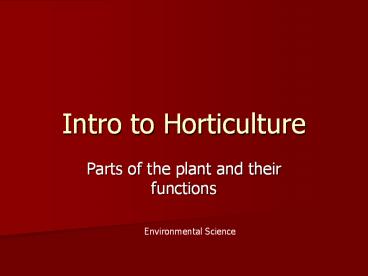Intro to Horticulture - PowerPoint PPT Presentation
Title:
Intro to Horticulture
Description:
Intro to Horticulture Parts of the plant and their functions Environmental Science Functions of leaves . 1. Critical for photosynthesis (the process by which plants ... – PowerPoint PPT presentation
Number of Views:149
Avg rating:3.0/5.0
Title: Intro to Horticulture
1
Intro to Horticulture
- Parts of the plant and their functions
Environmental Science
2
Functions of leaves
- .
1. Critical for photosynthesis (the process by
which plants produce their food).
2. Aid in the process of transpiration which is
necessary in order for plants to cool themselves.
3
3. Leaves can store some food which can later
be transferred to other areas of the plant.
4. Sometimes, leaves can be used in asexual or
vegetative propagation.
4
External Leaf Structures
- Leaves are consist of petiole and blade
- Blade is comprised of veins and a midrib
- The veins of the leaf form its structural
framework
- .
5
Internal Leaf Structures
- Epidermis
- Cuticle
- Waxy substance covers the leaves and stems
- Waterproof layer that keeps water in plants
6
Principal Tissues of the Leaf
- Epidermis (cont)
- Stomata
- Openings in the epidermis mainly located on
underside of leaves - Exchange of gases
- Guard Cells
- Two cells located on each side of stomata
- Open and closes stomata
7
Chloroplast
- More in cells located in the center of the leaf
- The chloroplast contains chlorophyll which gives
the plants the green color - Manufactures food for the plant though
Photosynthesis - Beginning of the food chain for most living things
8
Photosynthesis
CARBON DIOXIDE WATER LIGHT ENERGY GLUCOSE
OXYGEN
- Food manufactured by this process goes down to
the roots thought the stem. It is either used by
the plant or stored as a starch, sugar, or protein
9
Respiration
- Plants respire 24 hours/day just as animals
- In this process they consume carbon dioxide and
give off oxygen
10
What is the purpose of the stems?
- Two main Functions
- The movement of materials- water, minerals, food
- Support the leaves and reproductive structures
- Can be used for food storage
- Ex. Irish potato
11
What are the types of stems?
1) Woody Stem trees, shrubs, perennials 2)
Grass Stem hollow or filled 3) Herbaceous Stem
like wood but softer (clover, alfalfa) 4)
Modified Stem
12
Types of Modified Stems
- Bulbs (onion)
- Tubers (potato)
- Stolons above ground runner (strawberry)
- Rhizomes below ground runners (field bindweed or
creeping jenny)
13
What is the Terminal Bud?
- Terminal bud tries to make plant grow taller or
longer - if we remove terminal bud, the plant will be
shorter and thicker - Can you think of why we would want to do this??
- What kind of plants could we do this on??
14
Internal Stem Structure
- What does the Xylem Carry
- Water and minerals travel up
- What about the Phloem
- Manufactured food travels down the plant
- What does the Cambium do?
- Separates the xylem and the phloem
- Thin, green, actively growing tissue located
between the bark and the wood of a plant
15
Monocot vs. Dicot
- Dicot stem may continue to increase in diameter
because the cambium builds new phloem cells on
the outside and new xylem cells on the inside - Ex. Trees
- Monocot have vascular bundles which contain both
xylem and phloem and no cambium - This would make it more limited in size
- Ex. corn
16
Why should we care?
- The stems of some plants we use as food
- Irish potato and asparagus
- Others are used in building materials
- Lumber from the tree trunks
17
Roots
- Roots function
- Anchor the plant and hold it upright
- Absorb water and minerals from the soil and
conduct them to the stem - Store large quantities of plant food
- Propagate or reproduce some plants
18
(No Transcript)
19
Fibrous root vs. tap root
- Fibrous root system
- Much easier to transplant
- More spread out
- Tap root system
- Longer fewer roots
- End of root contains many root hairs
20
Functions of Fruit
1. Protect the seeds inside the ripened ovule
(fruit).
2. Provide nutrients to the soil and to a newly
germinated seedling.
21
3. Aid in the dissemination/spreading of seed by
providing food for animals.
Animals eat the fruit and seeds. After the
fruit is digested, the seeds pass out in the
animals feces at another location.
22
4. Some plants have dry, dehiscent fruits which
split open to disseminate seeds.
23
What is the purpose of seeds
- To continue the plant process
- There are two types
- Monocots
- dicots
24
Monocot and dicot
25
(No Transcript)































